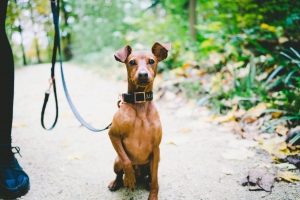Ask Crystal: Puppy Introductions
Welcome to “Ask Crystal,” where you can ask your pet behavior questions! You can submit your question for Crystal at the bottom of the page!

Dear Crystal,
I have a 8-month-old Shorkie. He barks a lot, tries to hump your arm, and gets so excited that his tongue hangs out. My son lives with me and he just got a 6-week-old Shih Tzu. We are taking time to let them get to know each other but my Bo goes crazy barking, whining and trying to lick her all over so we keep them separated. Is there anything we can do better to get them use to each other? Baby girl wants to be his friend. Help!
Sincerely,
Shorkie Mom
Dear Shorkie,
Congrats to your son on the new addition. You also have a puppy so congrats to you as well! In general, puppy introductions tend to go much more quickly than adult dog introductions and you should be able to have these two together having a great time in no time.
You don’t mention if Bo is neutered or not. I would highly suggest that one of the dogs be altered unless you are planning on having puppies. Female dogs can go into estrus as young as 6 months and small breed dogs like she is can go into estrus at 4 months so make sure you are being careful to prevent unplanned pregnancies.
It seems that Bo is a bit of a humper. In general, humping is more related to a dog’s excitement level than it is a sexual arousal. This is why we see this behavior in dog parks a lot. It can also be a stress related displacement behavior, so we see it in shelter dogs frequently. Some dogs don’t respond very well to those sorts of advances and some don’t mind. I have seen a few pairings where the dogs just take turns humping and neither is bothered by it. Once you start introducing them, if she is bothered by it, she may snap or growl and that is perfectly acceptable. Hopefully, he will get the message and stop. If not, you may need to let him drag a light line and say something like, “oops” and remove him for a break.
The behaviors of barking and whining when he is trying to get to her, sound like frustration behaviors. He is a puppy, and he likely does not have great self-control in this point of his life. Licking is a puppy behavior and is an affiliative gesture so that is a good sign. In addition, most puppies are dog social. Dog social dogs pretty much want to play with any other dog. This isn’t a hard and fast rule for all puppies but in general it is true. As dogs age, they become more selective about their friends so introductions tend to take longer, and they may not get along with every other dog. Without seeing the dog’s behavior, I cannot say his motivation for sure, but given his age and the licking, I would guess it is friendly in nature.
In general, I prefer for a dog to be calm before I allow it to greet another dog. There are a couple reasons for this. One is that I do not want to reinforce out of control behaviors and greetings by allowing the dog to be able to meet when they are behaving like that. Another reason is that the other dog may get the wrong impression if one dog is barking and going crazy. They may behave defensively if his intentions are unclear. Some dogs may take a long time to settle down enough to greet but hopefully you can get him to calm down before allowing a greeting.
The best places to introduce dogs is on neutral ground to prevent any territorial behavior from the resident dog. If you have a neighbor or friend with a fenced yard, that would be ideal. Other ideas might be a tennis court that allows dogs, a basement, or an empty dog park.
 Each dog should have a handler and stand with the dogs on leash on the opposite sides of the yard. Keep the leashes slack on your end and watch the dog’s body language. We are looking for soft curvy bodies, open mouths, open or squinty eyes, tails ideal at spine level. Body language that is less than ideal is stiff, still, closed mouth, hard eyes, tails that are straight up over the spine unless that is a natural tail position. If you see friendly behavior, approach each other until the dogs are about 10 feet away and drop the leashes. Keep the leashes on in case you need to grab the leash to break up an altercation. You never want to grab collars or put your hands into a dog fight. That is how most people seem to get bitten.
Each dog should have a handler and stand with the dogs on leash on the opposite sides of the yard. Keep the leashes slack on your end and watch the dog’s body language. We are looking for soft curvy bodies, open mouths, open or squinty eyes, tails ideal at spine level. Body language that is less than ideal is stiff, still, closed mouth, hard eyes, tails that are straight up over the spine unless that is a natural tail position. If you see friendly behavior, approach each other until the dogs are about 10 feet away and drop the leashes. Keep the leashes on in case you need to grab the leash to break up an altercation. You never want to grab collars or put your hands into a dog fight. That is how most people seem to get bitten.
At first there is likely to be some stiffness as they feel each other out. Hopefully, you will see some play bows and offers to play. They should begin to play. Once they seem comfortable, you may want to take the leashes off so that they can play without getting stuck on a leash. Keep an eye out for over arousal as that can tip into aggression if the dogs get too worked up and are allowed to play for too long. If you see them getting too worked up, call them away and take a break. You may choose to stop the play there and count that as a success. I like to stop on a good note, so I usually only let them play for ten minutes or so at a time in the beginning.
If you are seeing hard eyes or other behavior which is concerning, you may want to try to get the dog’s attention on you by bringing a treat up to their nose and redirecting them to you. You can choose to do some desensitization by reinforcing the dog for calmly looking at the other dog. When he looks at her, say “yes” and feed a high value treat. You may want to spend some time just working on calm behavior in her presence before proceeding with introductions. If is uncontrollable and you can’t get his attention, try to back him up to a further distance where he can be calm. Once he is calm, you could walk each dog around on leashes as you slowly decrease the distance.
Another way that I like to do introductions is by tandem walks. While greeting off leash is preferred because the dogs can move freely, sometimes it is not safe to do so. In those cases, we start off with the dogs on leashes. Again, we are in neutral territory for these intros. I like a quiet park for this introduction. Each handler walks the dog on the outside of themselves so that the people are on the inside. Walk far enough away so that the dogs cannot physically touch. If one dog uses the bathroom, allow the other dog to sniff it. Keep walking until the dogs are calm and let them greet for no more than 3 seconds. We keep it to three seconds to avoid any negative interactions. Walk some more and then let the dogs greet again. If their body language is friendly, you may find an off-leash area to let them play.
It’s important to note that most dogs do better with each other outside when they are new to each other. Inside the home, there are areas which have value to the dogs and areas that are confined and increase tension. My advice initially is to keep the pups separate inside and work on your introductions outside. As they gain comfort you can let them hang out in larger common areas for short periods of time. Avoid areas like kitchens, hallways, doorways in the beginning. You may use baby gates to keep a dog on one side of a room. I usually have the dogs on leash in common areas, so they get used to the presence of the other animal without the pressure of having to interact all of the time.
Prepare your house before integrating the two fully. Keep feeding areas separate. Dogs deserve to be able to eat in peace without competition. Pick up toys off the ground for now. As they show a bond, you can start introducing lower value toys and slowly start to increase the value of the toys. Only give bones or chews while the dogs are in their separate areas. This will also help create a special association with those areas. Avoid intense games like tug or fetch if the dogs might get too worked up or fight over a toy. As the dogs form a bond, you may be able to introduce high intensity games into the mix.
If you see behavior which is concerning, please consider having a Professional Dog Trainer come out and assist with the introductions. They will be able to tell you what they are seeing and when it’s good to proceed and when you need to stop. You may only need one visit for this purpose. Locate a certified trainer here.
It’s important to remember we are trying to create a relationship between the two dogs. Dogs are like us in that it takes some time to make a friend and even with a friend they may not want to hang out constantly in the beginning. It’s better to avoid problems then try to repair mistakes. Considering you have two puppies; I would expect the introduction to go much more quickly than it would with two adults. I appreciate your thoughtfulness in this introduction, and I am sure the dogs do as well. Good luck!
Until next time,
Crystal







